 Be Inspired Blog - Arizona
Be Inspired Blog - Arizona

Plant Succulents That Conserve Water And Look Beautiful
What Are Succulent Plants?
The word succulent is most commonly applied to food and used as a descriptor for dishes that are juicy and tender. The botanical definition isn’t too far off from that; it means plants that store water in their leaves, stems or both. There are many different types or species of succulents with a fascinating range of colors and shapes.
Succulents can tolerate prolonged drought, many for months and a few for years, and prefer bright light—but not always full hot sun. Other than Antarctica, succulents can be found growing naturally on every continent on Earth.
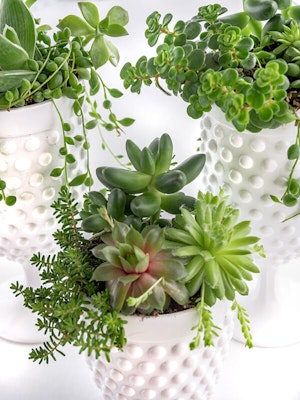 Growing Succulents Indoors
Growing Succulents Indoors
In fact, it’s succulents’ tolerance for dry conditions that makes them such a popular indoor plant. During winter especially, homes offer dry interior air to houseplants which is the reason so many traditional plants can struggle without customized care. If you’re choosing your first succulent, follow these easy steps to success.
- Choose an appropriate succulent for your conditions. Most succulents like direct sunlight, but if all you have is a shaded corner in your house, go with low light-tolerant plants like mother-in-law’s tongue. If you plan to grow your succulent in a hanging planter, a trailing variety like String of Bananas is a great choice. Always read the plant labels to determine the sunlight needs, size and spread of your succulents.
- Make sure your soil doesn’t hold on to water. Start with a coarse potting mix with good drainage and aeration. You can find special cactus and succulent mixes, such as E.B. Stone Organics Cactus & Succulent Potting or Planting Mix - which contains extra pumice for superior drainage. Make sure the mix is evenly moist before using.
- Choose your container and modify it if needed.
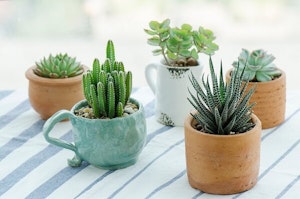 When planting your succulent, use a container that has drainage holes (or can have some added easily) and is at least one or two inches larger than the nursery container. Avoid glass containers in the long term as they don’t allow the roots to breathe and can cause root rot. Fill the bottom third with pre-moistened potting mix and then position your succulent inside. Backfill as needed with more pre-moistened potting mix.
When planting your succulent, use a container that has drainage holes (or can have some added easily) and is at least one or two inches larger than the nursery container. Avoid glass containers in the long term as they don’t allow the roots to breathe and can cause root rot. Fill the bottom third with pre-moistened potting mix and then position your succulent inside. Backfill as needed with more pre-moistened potting mix. - Place the potted succulent in a sunny place. Most succulents prefer at least six hours of sun each day, so try to place them in a south or east-facing window. Signs that your succulent is not getting enough sun include becoming spindly or growing to “stretch” towards the sun.
- Allow the potting mix to dry out between waterings. The number one mistake that people make with succulents is overwatering them. It’s best to offer more water less frequently rather than lighter but frequent wetting. To water properly, saturate the potting mix thoroughly (make sure the excess is flowing freely from the drainage holes) but allow the mix to dry out before the next watering. A good guide to watering is to insert a finger or wooden skewer two inches into the mix. If the soil is still moist at any point, you do not need to water. If the potting mix stays consistently wet every day, the plant may eventually die.
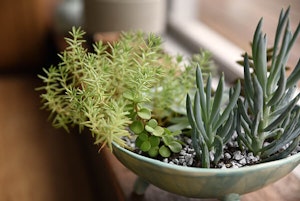
- Fertilize your succulents at least once a year. The plants benefit most from fertilizer in the spring, when the days get longer and new growth begins, and again in late summer. We recommend fertilizing your succulents with Grow More’s Cactus Juice or Miracle Gro’s Succulent Plant Food. Or, use a balanced, all-purpose, water-soluble fertilizer, such as Grow More's All-Season's Plant Food 20-20-20 diluted to half the strength recommended on the package instructions. There is no need to fertilize succulents in winter when they’re semi-dormant. They don’t need the nutrient boost because they are not actively growing.
Growing Succulents Outdoors
Outdoors, succulents are popular as stunning single focal-point plants, durable groundcovers for steep or difficult slopes, patio accents, or grouped in colorful combinations. Depending on the variety they can also be used in living sculptures (fences, wreathes, etc.), brush fire defense and even home-grown burglar prevention.
There are three main considerations when growing succulents outdoors:
- Temperatures (winter and summer)
- Rainfall (amount and timing)
- Sunlight (intensity and duration)
You can accommodate them all by choosing the right plants for your area, preparing the soil for better drainage and protecting those that need it from hot mid-summer sun.
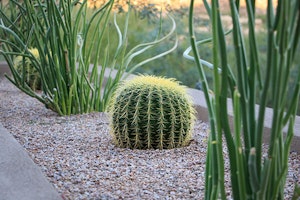
Temperature
Many popular garden succulents will tolerate mild freezes, even in the teens and lower, including certain aloes, senecios, golden barrel cactus, cholla, pincushion cactus, echeveria and graptopetalum. Keeping container plants close to buildings will help protect borderline species from cold injury.
During a heat wave, if temperatures fail to fall below 90 degrees overnight, it is best to suspend watering all together or bring containers indoors. These high temperatures prompt the plants to keep their stomata closed, which prevents water loss. When temperatures are regularly below 90 degrees overnight again you may resume the normal watering schedule.
Sun
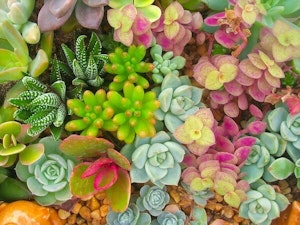
In general, all succulents do best in the sun, and many will get leggy and weak without at least six hours of sun daily. Others get more colorful and produce flowers with eight or more hours of direct sun. A good guideline is to examine the foliage – the more colorful it is, the more intense the sun it can take.
There are some varieties, however, that will fade, spot and even burn in the intense heat of full Arizona sun, especially when temperatures remain above 90 degrees or so. These varieties should be positioned to capture the morning sun or bright indirect sun. If they would be in direct sunlight during the hottest parts of the day, shade them with architecture or garden features like lattice, arbors, shade cloth or even large shade-providing trees.
During the winter, succulents in pots can be placed outdoors to encourage strong growth and enhance colors.
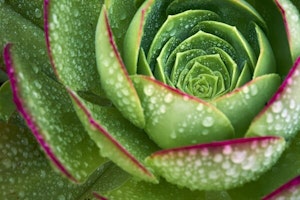
Rainfall
While succulents can tolerate dry periods for an extended length of time, they will do better and be more likely to flower with regular water during the active growing season. Varieties outdoor like opuntia, yucca, aloe, echinocereus, cylindropuntia, mammillaria, agave and delosperma can survive in most arid or summer-dry landscapes on rainfall alone, but to truly thrive they will need additional watering at least every few weeks.
Still, too much water is worse than not enough. Many gardeners keep outdoor succulents on the dry side during rainy weather to reduce the risk of root rot and help them survive lower temperatures. This may mean covering them from rain, or bringing any planters under a protected roof.
Planting Succulents Outdoors
Plant as early in the season as possible to allow the succulent as much time as possible to become established before the following winter or summer, but be prepared that they may require additional protection during that first year.
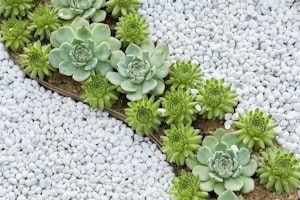
In most cases, the soil you plan to plant in will need amending before it is ideal. This mostly means increasing water drainage by mixing in E.B. Stone Organics Cactus & Succulent Potting or Planting Mix (which contains extra pumice for superior drainage), or by adding organic matter like compost, and up to 50 percent total volume with coarse sand, pumice or grit. Mix these into the top 6-8 inches of native soil.
Press the succulents into the dirt and compact the soil slightly around them as you go. Once all your succulents are planted, cover the remaining surface area with coarse sand or gravel. After allowing a day or two to settle, water the plants gently. Fertilize lightly in the spring with a low-nitrogen garden fertilizer.
Common Succulent Problems
Almost all common problems with succulents can be traced back to either too much or too little sun or water. Here are a few things you can watch for, and how to improve them.
Succulent Leaves Are Falling Off
The most common reason is watering issues. Too much water can cause the succulent’s leaves to swell, become soft and squishy and eventually fall off. The stem may also appear puffy.
To remedy this, withhold watering until the top two inches of soil are dry to the touch. Make sure the soil and container are draining freely and that the plant isn’t sitting in water for too long. If problems persist, consider repotting the plant entirely with well-draining soil. Allow the plant several days out of the soil to dry out and recover before repotting.
If you are confident in your watering schedule, it may be bacteria or fungus in the soil that is causing problems. Remove the succulent from the pot, discard the soil and give the container a thorough scrub before repotting with a fresh mix.
Leaves can also fall off during periods of intense heat and drought. This is a defense mechanism to help the plant conserve energy and maintain their water supply. This is a normal response in nature, but you can take steps to relieve some of the stress on your plant.
Move the succulent to a shadier location away from the intense, full sun. It may also need to be watered more frequently if the top two inches of soil are drying out faster than usual.
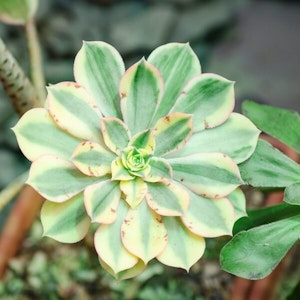
Succulent Has Yellow Leaves
Overwatering and underwatering can cause succulent leaves to turn yellow. Pay attention to other symptoms your plant may be showing. If your plant is well watered and the leaves feel mushy or swollen, the succulent is being overwatered. If the leaves are turning yellow, shriveling and wilting then the plant is most likely underwatered. Check the drainage of the soil and planter, and adjust your watering technique as needed.
A lack of nutrients can also cause new growth to appear yellow in color. Most commercial succulent potting soil comes with added compost of nutrients that the plant can feed on for some time, but eventually they will need to be replenished either by replacing the soil or adding a low-nitrogen fertilizer. Since succulents do not need a lot of fertilizer, dilute the amount recommended on the package by half. Feeding every two weeks during growing season should be enough.
Succulent Leaves Are Brown Or Have Dark Spots
The most common reason for brown or dark spots on the leaves is sun damage or sunburn. This can happen if the plant is left exposed to unfiltered full sun, or if the plant was recently moved to a much sunnier location without being acclimated. Even plants that are acclimated to full sun may experience sun damage during intense heat waves or droughts.
To remedy this, move the plant to a shady location, or provide cover during a heatwave. If you are moving your succulents from indoors to out, do so slowly by gradually increasing the duration and intensity of the sun it receives during the day.
Succulent Has Wilted Or Shriveled Leaves
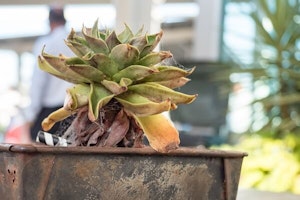
The main cause of wilting or shriveling is underwatering. If the leaves appear this way, especially starting at the top of the plant instead of the base, the succulent is most likely in need of some water.
Particularly during growing season or in the middle of a heatwave, succulents may need more water. Check the soil frequently for moisture by inserting a finger to the second knuckle. Anytime the soil is dry to the touch, water thoroughly.
Succulent Has Dead Lower Leaves
The lower leaves of a succulent will naturally wither and die as the plant grows and begins to produce new leaves. Dead leaves can be removed, or you can wait until they fall off on their own. Make sure to remove any dead leaves right away to avoid providing cover on the soil for insects and bugs, fungus and bacteria from hiding there.
Succulent Is Stretching Out
If a succulent does not receive enough light where it is, the stems will begin to “stretch” towards a better source in a process called etiolation. You may notice the stem growing in the direction of a sunnier spot, with a widening gap between leaves and a thinning of the stem. The succulent’s growth is significantly weakened in this state.
To fix the problem, move the plant to a brighter location. Make sure to do it in stages so that the succulent can acclimate and will be at less risk for suffering sun damage. If you are unable to provide additional light for your indoor succulents, a grow light is an alternative solution. Monitor your succulent as you make changes and continue adjusting as needed.
Is Your Succulent Really Dead?
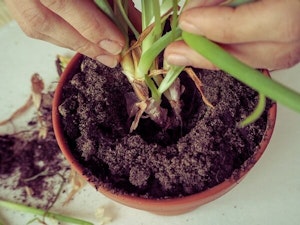
Despite your best intentions, is your succulent on death’s door? These plants are resilient, and it might amaze you how able they are to rebound. The key to knowing if there’s any hope left is by removing the plant from the soil and giving it a thorough look from tip to root.
If you see enough viable roots, your plant may have a chance. But if the roots have rotted, turned black or dried up and turned brown, then it might be time to say goodbye. Also examine the leaves and stem – if parts of the plant are still firm and appear healthy, cut off the mushy parts and let the remaining succulent dry and heal for a few days before replanting in fresh soil and allowing it to grow new roots.
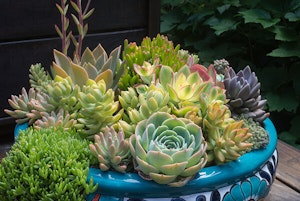 Have More Questions About Succulents?
Have More Questions About Succulents?
If you have more questions about succulents, or want some specific advice on which varieties might be best in your yard, stop in to any of our three locations to speak with one of our gardening experts. We carry a wide variety of plants, planters, soils and fertilizers for all your succulent needs.

